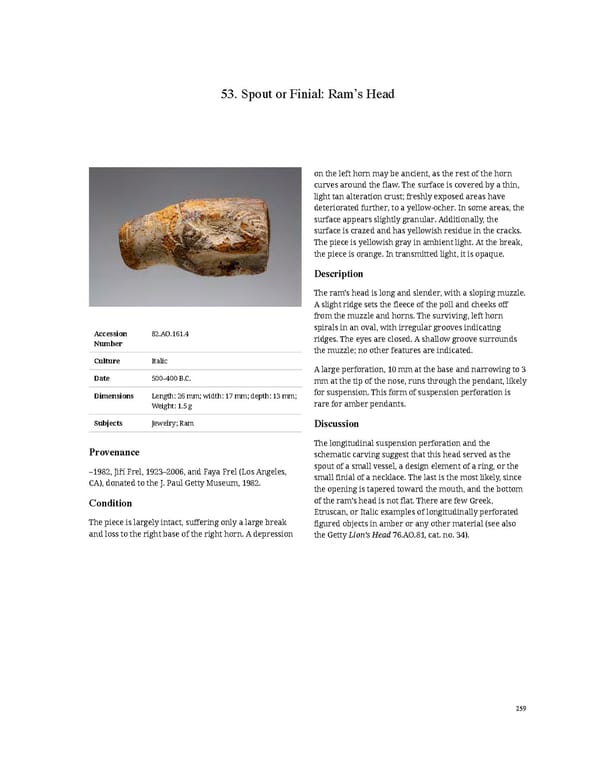53. Spout or Finial: Ram’s Head on the left horn may be ancient, as the rest of the horn curves around the flaw. The surface is covered by a thin, light tan alteration crust; freshly exposed areas have deteriorated further, to a yellow-ocher. In some areas, the surface appears slightly granular. Additionally, the surface is crazed and has yellowish residue in the cracks. The piece is yellowish gray in ambient light. At the break, the piece is orange. In transmitted light, it is opaque. Description The ram’s head is long and slender, with a sloping muzzle. A slight ridge sets the fleece of the poll and cheeks off from the muzzle and horns. The surviving, left horn Accession 82.AO.161.4 spirals in an oval, with irregular grooves indicating Number ridges. The eyes are closed. A shallow groove surrounds the muzzle; no other features are indicated. Culture Italic A large perforation, 10 mm at the base and narrowing to 3 Date 500–400 B.C. mm at the tip of the nose, runs through the pendant, likely Dimensions Length: 26 mm; width: 17 mm; depth: 13 mm; for suspension. This form of suspension perforation is Weight: 1.5 g rare for amber pendants. Subjects Jewelry; Ram Discussion Provenance The longitudinal suspension perforation and the schematic carving suggest that this head served as the –1982, Jiří Frel, 1923–2006, and Faya Frel (Los Angeles, spout of a small vessel, a design element of a ring, or the CA), donated to the J. Paul Getty Museum, 1982. small finial of a necklace. The last is the most likely, since the opening is tapered toward the mouth, and the bottom Condition of the ram’s head is not flat. There are few Greek, Etruscan, or Italic examples of longitudinally perforated The piece is largely intact, suffering only a large break figured objects in amber or any other material (see also and loss to the right base of the right horn. A depression the Getty Lion’s Head 76.AO.81, cat. no. 34). 259
 Ancient Carved Ambers in the J. Paul Getty Museum Page 268 Page 270
Ancient Carved Ambers in the J. Paul Getty Museum Page 268 Page 270